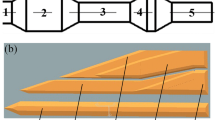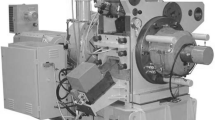Abstract
The applicability of a wedge-joint mechanism with a curving wedge in presses for the implementation of metal forming separation processes was substantiated. The paper states the fact that the wedge-joint mechanism graph of the deformation force change is the closest to the technological typical graph of the force change during separation. At the same time, the wedge-joint mechanism with a curving wedge has a lower height of the parts in comparison with the traditional crank mechanisms, which provides less elastic deformation and press dynamics. The use of the additional wedge mechanism in a press with the wedge-joint mechanism with a curving wedge to ensure the approximation motion is proved. This makes it possible to reduce the energy consumption for elastic deformation and further reduce the dynamic force. The mathematical models of the wedge-joint mechanism with a curving wedge, presented in the form of a two-slide link mechanism, were developed, allowing to perform its structural, kinematic, and dynamic analysis. Based on the analysis of the proposed mathematical models, dependencies were identified and a procedure for calculating the geometric, kinematic, and power parameters of wedge-joint mechanisms with a curving wedge for separation processes was developed. Comparison of the kinematic and dynamic analyses results carried out by analytical and graphic-analytical methods confirms the reliability of estimates, since their discrepancy is not more than 2.5%. Experimental studies have confirmed the adequacy of mathematical models. The error between the calculated and measured values of the forces on the slide does not exceed 10%.











Similar content being viewed by others
References
Jha S, Ranjan VK, Pal (2017) Application of emerging technologies in ERP implementation in Indian manufacturing enterprises: an exploratory analysis of strategic benefits. Int J Adv Manuf Technol 88:369–380. https://doi.org/10.1007/s00170-016-8770-6
Lisunets NL (2018) Improving the efficiency of the processes of billets manufacture from rolled metal via shift cutting based on simulation. Chernye Metally (6):31–35
Lisunets NL (2019) Usage of physical and mathematical simulation for improvement of the processes of metal shear cutting. CIS Iron and Steel Review 17:34–38 https://www.scopus.com/authid/detail.uri?authorId=6508354482
Liu Y, Hua L, Mao H, Feng W (2014) Finite element simulation of effect of part shape on forming quality in fine-blanking process. Procedia Eng 81:1108–1113
Osakada K, Mori K, Altan T, Groche P (2011) Mechanical servo press technology for metal forming. CIRP Ann Manuf Technol 60:651–672
Karnauh S, Karnaukh D (2011) Research of the influence of deformation speed on energy and power adjectives of the process of three-point cold bend breaking and on alignment integrity of raw parts. Metallurgical and Mining Industry.
Karnaukh SG (2001) Studying the process of static-dynamic loading of a preform according to the scheme of three-point breaking by bending in press-hammers. Kuznechno-Shtampovochnoe Proizvodstvo (Obrabotka Metallov Davleniem)
Karnaukh SG, Markov OE, Aliieva LI, Kukhar VV (2020) Designing and researching of the equipment for cutting by breaking of rolled stock. Int J Adv Manuf Technol 109:2457–2464
Hu XH, Choi KS, Sun X, Golovashchenko SF (2014) Edge fracture prediction of traditional and advanced trimming processes for AA6111-T4 sheets. J Manuf Sci Eng 136:021016 (11 pages)
Kim S, Tsuruoka K, Yamamoto T (2014) Effect of forming speed in precision forging process evaluated using CAE technology and high performance servo-press machine. Procedia Eng 81:2415–2420
Luo C, Chen Z, Zhou K, Yang X, Zhang X (2017) A novel method to significantly decrease the die roll during fine-blanking process with verification by simulation and experiments. J Mater Process Tech 250:254–260
Zhao PJ, Chen ZH, Dong CF (2016) Experimental and numerical analysis of micromechanical damage for DP600 steel in fine-blanking process. J Mater Process Technol 236:16–25
Gao M, Wang Q, Li L et al (2019) Comprehensive energy-saving method for sheet metal forming. Int J Adv Manuf Technol 104:2273–2285. https://doi.org/10.1007/s00170-019-04022-4
Huang G, Wang J, Hsu M, Huang K, Chen T, Chen T (2017) Application of mold trough design to blanking technology. Int J Adv Manuf Technol 88:1025–1034
Krobath M, Klünsner T, Ecker W, Deller M, Leitner N, Marsoner S (2018) Tensile stresses in fine blanking tools and their relevance to tool fracture behavior. Int J Mach Tools Manuf 126:44–50
Xiao Y, Zhang H, Jiang Z (2016) An approach for blank dimension design considering energy consumption. Int J Adv Manuf Technol 87:1229–1235. https://doi.org/10.1007/s00170-015-8048-4
Chehab AG, Naggar EL (2003) Design of efficient base isolation for hammers and presses. Soil Dyn Earthq Eng 23:127–141. https://doi.org/10.1016/S0267-7261(02)00157-4
Jomartov A, Tuleshov A, Kuatova M (2020) Dynamic model of a crank press in the process of braking. В: Kuo C-H, Lin P-C, Essomba T, Chen G-C (eds.) Robotics and Mechatronics. Springer International Publishing Cham. 141-150
Mull J, Durand C, Baudouin C et al (2020) A new tailored solution to predict blow efficiency and energy consumption of hammer-forging machines. Int J Adv Manuf Technol 111:1941–1954
Telegin V, Kozlov A (2016) Computer realization of research into the dynamics of mechanical systems. IOP Conf Ser: Mater Sci Eng 124(1)
Telegin VV, Kozlov AM, Sakalo VI (2017) Solid modeling and dynamic analysis of mechanisms of press-forging machines. Procedia Eng 206:1258–1263
Won C, Lee W, Lee H, Kang YS, Yoon J (2020) Effect of two-stage press blanking on edge stretchability with third-generation advanced high-strength steels. Int J Adv Manuf Technol 110:13–27. https://doi.org/10.1007/s00170-020-05854-1
Patent for corisna model №134608 (Ukraine) MPK (2006) B23D 23/00. Wedge press / Roganov L. L., Chosta N. V. – Appl. 03.12.2002; Publ. 03.17.2003, Bul. No. 3, 2003 p., 4 p
Data and materials availability
Not applicable.
Code availability
Not applicable
Author information
Authors and Affiliations
Contributions
Sergii G. Karnaukh: developed research method.
Nataly V. Chosta: calculation of the forces ensuring in the stamp
Oleg E. Markov: force analysis.
Volodymyr V. Kukhar: literature review.
Corresponding author
Ethics declarations
Ethics approval and consent to participate
This manuscript was submitted to only one journal. The submitted work is original and do not have been published elsewhere in any form or language (partially or in full). Results have been presented clearly, honestly, and without fabrication, falsification or inappropriate data manipulation (including image based manipulation). Authors adhered to rules for acquiring, selecting and processing data. Data, text and theories were the authors own. Proper acknowledgements to other works were be given and summarized.
Consent for publication
Not applicable.
Conflict of interest
The authors declare no competing interests.
Additional information
Publisher’s note
Springer Nature remains neutral with regard to jurisdictional claims in published maps and institutional affiliations.
Rights and permissions
About this article
Cite this article
Karnaukh, S.G., Chosta, N.V., Markov, O.E. et al. Development and research of the press operating mechanism, made in the form of the wedge-joint mechanism with a curving wedge for separation operations. Int J Adv Manuf Technol 116, 3305–3314 (2021). https://doi.org/10.1007/s00170-021-07718-8
Received:
Accepted:
Published:
Issue Date:
DOI: https://doi.org/10.1007/s00170-021-07718-8




